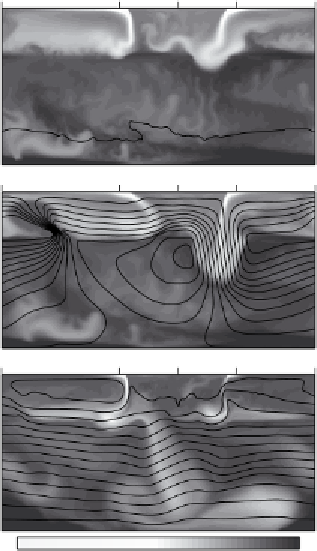Geology Reference
In-Depth Information
(a)
1312. Myr
(b)
1314. Myr
(c)
1318. Myr
0.0
1800.
Temperature
Figure 9.12. Detail of an overturn in the model of Figure 9.10. Cool fluid from
the upper mantle drops into the lower mantle, and hot fluid from the lower mantle
floods the upper mantle, suddenly raising its temperature. Layering is quickly re-
established and the stratified temperature structure is well established by 1500 Myr
(Figure 9.10). After Davies [156]. Copyright Elsevier Science. Reprinted with
permission.
indicative. Any thick accumulations of mafic material could be expected to founder
once they reached thicknesses of around 60 km and their bases transformed to dense
eclogite, in which case the mafic crust would recycle into the mantle anyway.
Between overturns the oceanic crust thickness is only 2-4 km, so its buoyancy
would offer little hindrance to subduction. Thus a form of upper-mantle convection,
as implicit in the model, is plausible, and these plates would cool the upper mantle.
The lower mantle, lacking any contact with the cold surface of the Earth, would lose
heat only slowly, and its internal radioactivity actually warms it between overturns.
This can be inferred, for example, by the fact that the mean temperature increases
as a new overturn is approached. The reason it increases is that heat loss through
the surface drops rapidly as the upper mantle cools and drops below the radioactive
heating rate (see Figure 9.11(b)).

